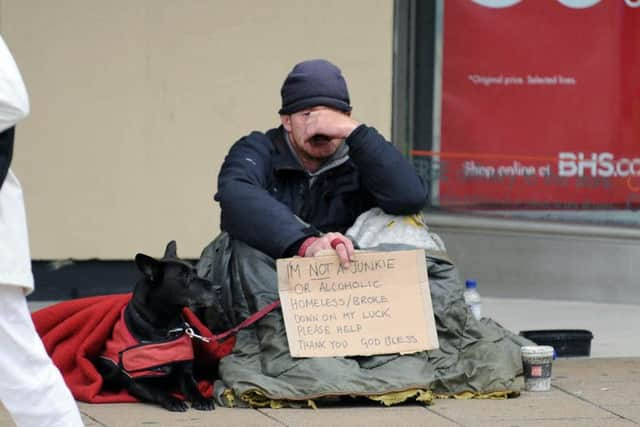Edinburgh’s homeless could stay in private homes instead of B&Bs under council plans
This article contains affiliate links. We may earn a small commission on items purchased through this article, but that does not affect our editorial judgement.
and live on Freeview channel 276
Councillors have approved a five-year rapid rehousing transition plan, that will attempt to halt the reliance on temporary accommodation for those presenting in the city of homeless – but officers admitted the authority “would not be able to achieve the Scottish Government’s ambition in full within the five years”.
An innovative model as part of the plan could result in some people accommodated in a room within a private home in a supported lodging scheme. Similar models have provided support for community hosts through specialised training.


Advertisement
Hide AdAdvertisement
Hide AdIn Scotland, supported lodging schemes have primarily been used for young people leaving care – but if a £30,000 feasibility study for the scheme is approved, a pilot could be launched in Edinburgh. The annual costs are thought to be around £35,000 – where at least 100 places could be created over the next five years.
The council will also apply for funding to trial a shared tenancy scheme where homeless people could live together in shared flats.
Housing and economy convener, Cllr Kate Campbell, said: “To help us take people out of bed and breakfast accommodation we need to be prepared to embrace lots of different, innovative solutions.
“We’ve been prioritising families but we’ve always said that ending B&B use altogether is our absolute goal. This will take time and we have to look at different models and approaches to providing temporary accommodation. And we must acknowledge that every individual is different and will have different needs.”
Advertisement
Hide AdAdvertisement
Hide AdShe added: “Matching people to a shared tenancy would have to be done carefully, and it would have to be something people wanted, not something we would impose. But for lots of people it could have significant benefits – not just cheaper rent and bills, but also having a flat mate can be a positive experience. And, of course, it could really speed up the process of single people moving into settled tenancies.
“Supported lodgings is another model that we think could work. People would provide a room in their own home, and a commitment to help support that person towards more positive outcomes. This is a model that has traditionally been used for young people but we want to explore how it could work for other vulnerable groups. Again, it wouldn’t be right for everyone but for some people it could be exactly the type of support they need.”
The plans highlights that supported lodging schemes “have demonstrated a range of positive outcomes for young people at risk of homelessness”, including health and wellbeing, life-skills, education and employment.
Overall, the council is applying for a total of £9.2m from the Scottish Government’s £15m ending homelessness fund – which will be divided amongst all 32 local authorities in Scotland. It is likely the council will need to prioritise measures in the plan to be taken forward.
Advertisement
Hide AdAdvertisement
Hide AdMillions more funding will be required to build enough affordable homes – with currently 70 per cent of the council’s stock going to homeless people, against a Scotland average of 41 per cent.
Conservative housing spokesperson, Cllr Cameron Rose, raised concerns about the focus from some corners of the council about the need to build more homes. The authority has pledged to build 10,500 affordable homes by 2024.
Cllr Rose said: “One of the key measures is simply more houses – ultimately it’s probably more houses being built.
“I’m not convinced the whole of the council is working towards that immediate goal.”
Advertisement
Hide AdAdvertisement
Hide AdCllr Rose quizzed council officers about the barriers to building more homes in the Capital.
Michael Thain, the council’s head of place development, said: “The fundamental challenge we face in providing more affordable housing is primarily around land and the ability to innovate.”
Liberal Democrat Cllr Kevin Lang, highlighted fears that the five-year plan could become “quite disjointed” if the council does not “escalate this to more of a political level for further discussions with the Scottish Government”.
He added: “This is a complex problem that’s going to require a range of solutions. Looking at everything in a one-year snapshot is not going to help.”
Advertisement
Hide AdAdvertisement
Hide AdCllr Campbell agreed that the plan “has to be more joined up” and said that funding discussions could take place with the Scottish Government through the umbrella body for local authorities, COSLA.
Green housing spokesperson, Cllr Susan Rae, said: “The rapid rehousing transition plan is an important step forward in tackling the homelessness crisis in the Capital. With almost £13m a year being spent on homeless bed and breakfast places alone, it is absolutely right to seek to reduce time spent in temporary accommodation and get people into permanent homes as quickly as possible.
“However, it also highlights the huge shortfall in council and housing association homes. Edinburgh has only about a third of the council homes it had 40 years ago, despite the population swelling over that time. The city is way out on a limb within Scotland in the scale of homelessness and housing pressures we face.”
To keep up-to-date with all our stories from across Edinburgh and the Lothians like our Facebook page and follow us on Twitter.
Sign up to our newsletter: enter your email in the box at the top of this article to get daily updates straight to your inbox.